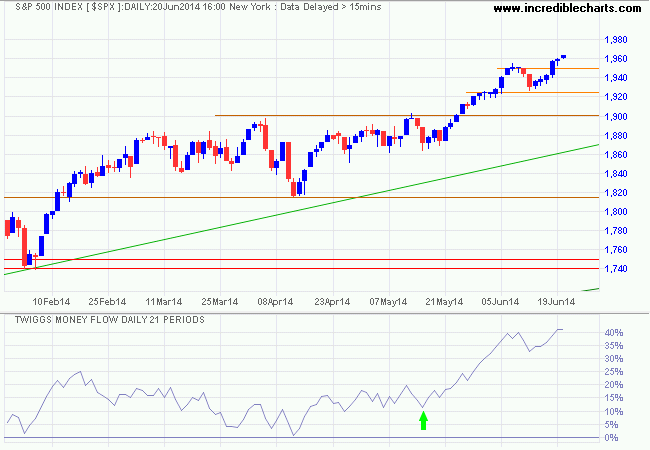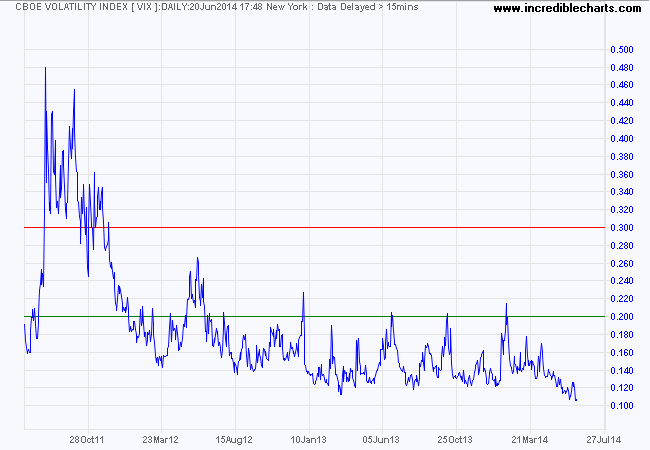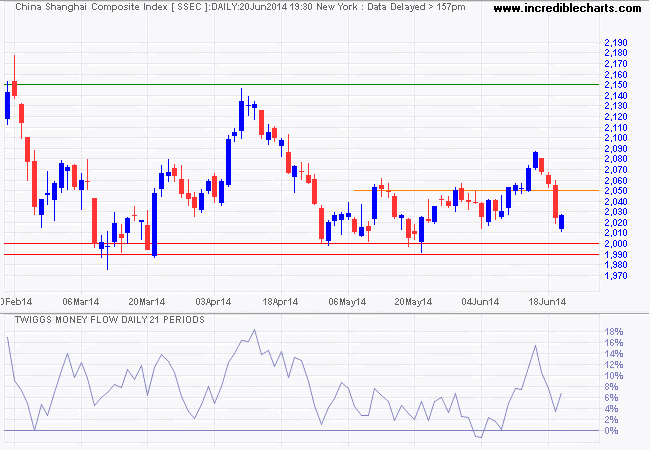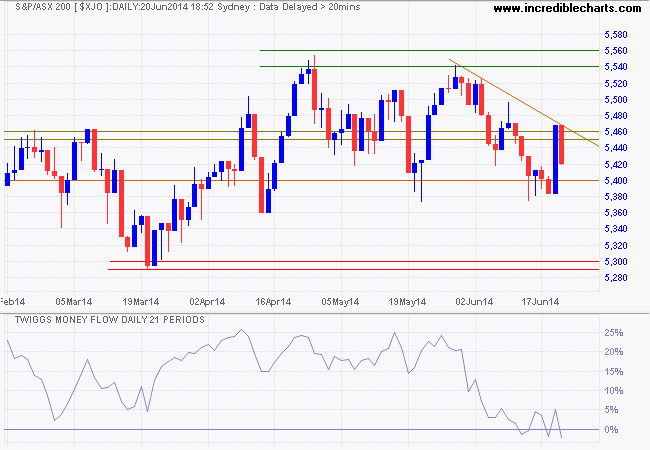A good week for the S&P 500 but not the ASX
By Colin Twiggs
June 21st, 2014 10:00 a.m. AEST (8:00 p:m EDT)
Advice contained herein is provided for the general information of readers and does not have regard to any particular person's investment objectives, financial situation or needs. Accordingly, no reader should act on the basis of any information herein without first having consulted a suitably qualified financial advisor.
Summary:
- Good week for US markets.
- China continues to threaten further down-side.
- The ASX 200, pulled in opposite directions, is range bound for the present.
- Momentum strategies require persistence.
The S&P 500 broke through 1950 and is expected to test the next resistance level at 2000*. Rising 21-day Twiggs Money Flow signals medium-term buying pressure. Reversal below 1925 is unlikely at present but would warn of a correction.

* Target calculation: 1900 + ( 1900 - 1800 ) = 2000
The CBOE Volatility Index (VIX) continues its downward path, indicating low risk typical of a bull market.

The Shanghai Composite Index rebounded Friday after a tough week and continues to test primary support at 1990/2000. Breach of support would signal a decline to 1850*. 21-Day Twiggs Money Flow oscillating above zero indicates buying support; a fall below zero would suggest selling pressure. The primary trend is expected to continue its downward path, but this is a managed descent and an abrupt fall seems unlikely.

* Target calculation: 2000 - ( 2150 - 2000 ) = 1850
After a strong surge on Thursday the ASX 200 retreated below 5450 on Friday, suggesting another test of support at 5400. Reversal of 21-day Twiggs Money Flow below zero indicates medium-term selling pressure. Breach of support is likely and would indicate a correction to 5300. Recovery above 5500 is unlikely at present, but the long-term trend remains upward.

* Target calculation: 5400 + ( 5400 - 5000 ) = 5800
Resist the urge to avoid discomfort
Momentum stocks have suffered a fair degree of turbulence since April, after a strong first quarter. Investors unfortunately have to endure periods like this, when the market appears hesitant or lacks direction, in much the same the same way as travelers can expect turbulence during an air flight. It is important is to resist the urge to avoid discomfort by exiting positions. Enduring uncomfortable parts of the journey are necessary if you want to reach your intended destination. Our research on both the ASX and S&P 500 has shown that attempting to time secondary movements in the markets does not enhance but erodes performance: the average (re-)entry price is higher than the average exit price after accounting for brokerage.
A basic rule of thumb in investing is that investors need to endure higher volatility in order to achieve higher returns. If your investment time frame is long-term, it is important to focus on the end result and not be overly concerned by weekly fluctuations.
The first lesson of economics is scarcity: there is never enough of anything to fully satisfy all those who want it. The first lesson of politics is to disregard the first lesson of economics.
~ Thomas Sowell
Disclaimer
Research & Investment Pty Ltd is a Corporate Authorized Representative (AR Number 384 397) of Andika Pty Ltd which holds an Australian Financial Services Licence (AFSL 297069).
The information on this web site and in the newsletters is general in nature and does not consider your personal circumstances. Please contact your professional financial adviser for advice tailored to your needs.
Research & Investment Pty Ltd ("R&I") has made every effort to ensure the reliability of the views and recommendations expressed in the reports published on its websites and newsletters. Our research is based upon information known to us or which was obtained from sources which we believe to be reliable and accurate.
No guarantee as to the capital value of investments, nor future returns are made by R&I. Neither R&I nor its employees make any representation, warranty or guarantee that the information provided is complete, accurate, current or reliable.
You are under no obligation to use these services and should always compare financial services/products to find one which best meets your personal objectives, financial situation or needs.
To the extent permitted by law, R&I and its employees, agents and authorised representatives exclude all liability for any loss or damage (including indirect, special or consequential loss or damage) arising from the use of, or reliance on, any information. If the law prohibits the exclusion of such liability, such liability shall be limited, to the extent permitted by law, to the resupply of the said information or the cost of the said resupply.
Important Warning About Simulated Results
Research & Investment (R&I) specialise in developing, testing and researching investment strategies and systems. Within the R&I web site and newsletters, you will find information about investment strategies and their performance. It is important that you understand that results from R&I research are simulated and not actual results.
No representation is made that any investor will or is likely to achieve profits or losses similar to those shown.
Simulated performance results are generally prepared with the benefit of hindsight and do not involve financial risk. No modeling can completely account for the impact of financial risk in actual investment. Account size, brokerage and slippage may also diverge from simulated results. Numerous other factors related to the markets in general or to the implementation of any specific investment system cannot be fully accounted for in the preparation of simulated performance results and may adversely affect actual investment results.
To the extent permitted by law, R&I and its employees, agents and authorised representatives exclude all liability for any loss or damage (including indirect, special or consequential loss or damage) arising from the use of, or reliance on, any information offered by R&I whether or not caused by any negligent act or omission.
